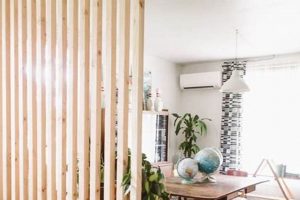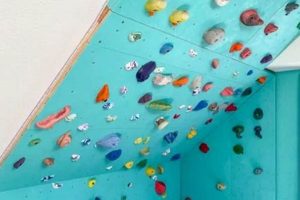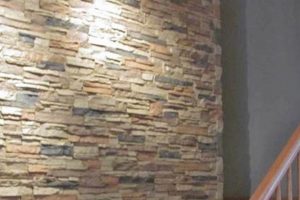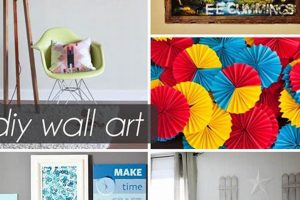A decorative backdrop created using artificial or dried botanical elements, frequently employed for aesthetic enhancement at events, in retail spaces, or as a photographic setting, is a popular design element. The construction process typically involves adhering individual floral components to a supporting structure, such as a fabric panel or a wire grid.
The appeal of constructing a botanical display lies in its capacity to introduce visual texture and color, transforming an otherwise ordinary space. Historically, floral ornamentation has signified celebration and beauty; contemporary applications extend this tradition by providing customizable and cost-effective decorative solutions. This approach allows for personalized designs tailored to specific themes or color palettes.
The subsequent sections will elaborate on material selection, construction techniques, installation methods, and design considerations pertinent to creating a bespoke floral feature.
Creating Botanical Backdrops
Achieving a visually compelling and structurally sound floral display requires careful planning and execution. The following guidelines offer valuable insights for successful construction.
Tip 1: Material Selection: Prioritize durable, high-quality artificial flowers that resist fading and physical degradation. Silk or realistic synthetic materials offer longevity and visual appeal.
Tip 2: Support Structure Integrity: Select a robust and stable foundation, such as a plywood panel or a heavy-duty wire grid. Ensure the structure can bear the weight of the affixed botanical elements.
Tip 3: Adhesion Techniques: Employ adhesives specifically formulated for floral applications. Hot glue provides a secure bond, while floral wire offers flexibility for intricate arrangements.
Tip 4: Color Palette Harmony: Establish a cohesive color scheme to create a visually balanced and aesthetically pleasing composition. Consider complementary or analogous color relationships.
Tip 5: Floral Density and Distribution: Achieve a consistent floral density across the surface, avoiding sparse or overly crowded areas. Stagger flower placement for a natural, organic appearance.
Tip 6: Dimensional Layering: Incorporate variations in flower size and depth to create visual interest and prevent a flat, two-dimensional effect. Varying the height and projection of individual blooms adds dynamism.
Tip 7: Secure Mounting: Employ appropriate mounting hardware, such as wall anchors or heavy-duty hooks, to ensure the structure is securely affixed to the intended surface. Verify load-bearing capacity before installation.
Careful adherence to these guidelines will result in a durable, visually striking botanical feature that enhances any environment.
The concluding section will summarize the key benefits and potential applications of custom-made floral features.
1. Floral Material Selection
The selection of floral materials constitutes a foundational aspect of creating a custom botanical display. This choice dictates the aesthetic properties, longevity, and overall feasibility of the project. The quality and type of materials directly influence the visual impact and durability of the finished product.
- Material Realism and Visual Impact
The degree of realism in artificial flowers significantly impacts the perceived quality of the display. High-quality silk or synthetic flowers that closely mimic natural blooms contribute to a sophisticated and believable aesthetic. Conversely, inexpensive, unrealistic materials can detract from the overall visual appeal, resulting in a less convincing outcome. For example, opting for silk roses with subtle color variations and realistic petal textures over generic plastic flowers enhances the overall visual impact.
- Material Durability and Longevity
The chosen materials must withstand environmental factors, such as UV exposure and temperature fluctuations, to ensure the botanical display maintains its visual integrity over time. Durable materials like UV-resistant synthetic fabrics or treated dried flowers resist fading, discoloration, and degradation, extending the lifespan of the arrangement. Conversely, materials susceptible to damage may require frequent replacement or repairs, increasing maintenance efforts. For example, using UV-protected synthetic hydrangeas instead of untreated silk flowers prevents fading and discoloration when exposed to sunlight.
- Material Weight and Structural Considerations
The weight of floral materials influences the structural requirements of the support system. Lightweight materials, such as foam flowers or delicate paper blooms, place minimal stress on the frame, allowing for simpler and less robust construction. However, heavier materials, such as dense silk flowers or preserved foliage, necessitate a sturdier frame and more secure attachment methods to prevent sagging or collapse. Careful consideration of material weight is crucial for ensuring the stability and longevity of the entire construction. For example, substituting heavy silk peonies with lighter foam peonies can reduce the overall weight of the floral display, easing installation.
- Material Cost and Budget Constraints
The selection of floral materials is often constrained by budgetary limitations. High-quality silk or preserved flowers typically command a higher price point than mass-produced synthetic alternatives. Balancing the desire for visual realism and durability with financial considerations requires careful planning and prioritization. Exploring cost-effective alternatives, such as mixing high-end focal blooms with less expensive filler flowers, can help achieve the desired aesthetic without exceeding budget constraints. For example, using a combination of premium silk roses for the central arrangement and less expensive synthetic greenery as a backdrop can optimize costs without sacrificing overall visual appeal.
In conclusion, the selection of appropriate floral materials is paramount to the success. Careful consideration of visual realism, durability, structural impact, and budgetary constraints ensures the resulting custom botanical display meets the desired aesthetic standards and provides lasting visual enhancement. The initial investment in quality materials directly translates to a longer lifespan and a more impactful final presentation.
2. Structural Support System
The structural support system provides the necessary framework for the creation of a stable and visually cohesive botanical display. Its design and implementation directly impact the longevity, presentation, and ease of installation.
- Material Selection and Load-Bearing Capacity
The selection of materials for the support structure dictates its ability to withstand the weight of the attached floral elements. Materials such as plywood, metal grids, or rigid plastic panels each offer distinct advantages in terms of load-bearing capacity and durability. Inadequately reinforced structures are prone to warping, sagging, or complete failure, compromising the overall aesthetic and safety. For instance, a plywood backing secured with appropriate bracing provides a stable foundation for a dense arrangement of silk flowers, preventing deformation over time.
- Framework Dimensions and Spatial Considerations
The dimensions of the support system must align with the intended scale and spatial context of the botanical display. Overly large structures may dominate the environment, while undersized frameworks can limit design possibilities and appear disproportionate. Careful consideration of the installation location and surrounding architecture is crucial for determining the appropriate dimensions. For example, a narrow, vertical metal grid is suitable for creating a slender botanical accent in a small retail space, whereas a large plywood panel is more appropriate for covering an entire wall in a spacious event venue.
- Attachment Mechanisms and Floral Integration
The design of the support system should facilitate secure and efficient attachment of the floral elements. Pre-drilled holes, integrated wire mesh, or adhesive-compatible surfaces streamline the process of affixing individual blooms or foliage. The attachment mechanism should be concealed or aesthetically integrated into the overall design to avoid detracting from the visual appeal. For instance, using floral wire to attach stems to a wire grid allows for flexibility in arrangement while minimizing visible hardware.
- Portability and Installation Flexibility
The design of the support system can significantly influence the ease of transportation, setup, and dismantling. Lightweight, modular frameworks offer greater flexibility for temporary installations or repositioning. Integrated hanging hardware, such as D-rings or adjustable brackets, facilitates secure mounting to various surfaces. A portable, self-supporting frame allows for placement in a variety of locations without requiring permanent wall modifications. For example, using a foldable A-frame stand allows for easy transport and setup of a floral backdrop at different event locations.
The successful integration of a structural support system is paramount to the creation of an aesthetically pleasing and structurally sound display. Considerations such as material selection, dimensional accuracy, attachment methods, and portability influence the final presentation and the overall success. Prioritization of these factors ensures that the botanical exhibit serves as an enduring and visually appealing enhancement to its environment.
3. Adhesive Application Techniques
Adhesive application techniques are critical to the structural integrity and aesthetic longevity of a self-assembled botanical display. The success of permanently affixing individual floral components to a chosen backing material rests directly on the correct selection and deployment of adhesive compounds. Improper techniques can lead to detachment, misalignment, and ultimately, a compromised visual appearance. For example, the use of a low-temperature glue gun on a fabric backing might result in insufficient adhesion, particularly with heavier floral elements such as silk roses or hydrangeas. Conversely, excessive application of adhesive can create visible residue or distortion, detracting from the naturalistic effect.
The selection of adhesive should correspond with the material properties of both the floral components and the substrate. Hot glue, while frequently employed for its rapid setting time, may not be suitable for delicate materials or environments with high temperatures. Alternatives include specialized floral adhesives, epoxy resins, or industrial-strength tapes, each offering varying degrees of bond strength, flexibility, and resistance to environmental factors. The precise application method whether through a dispensing gun, brush, or direct transfer influences the uniformity and strength of the bond. A controlled, even application is necessary to ensure consistent adhesion across the entire surface. Consider a scenario where multiple individuals contribute to the construction of a botanical display; standardized training in adhesive application techniques becomes essential to maintain quality control.
In summary, the successful execution of a self-assembled botanical display hinges on the meticulous application of appropriate adhesive compounds. This process demands a comprehensive understanding of material properties, application methods, and environmental considerations. Overlooking this critical element can undermine the structural integrity and visual appeal of the finished product, thereby negating the intended aesthetic impact.
4. Color Palette Coordination
Effective color palette coordination is paramount to the aesthetic success of a botanical display. The selected colors establish the visual tone and impact, influencing the perceived mood and overall cohesiveness. Harmonious color choices enhance the visual appeal, while discordant selections can detract from the intended effect.
- Establishing a Focal Point Through Color Contrast
Strategic use of contrasting colors directs visual attention and creates a focal point within the display. Utilizing complementary colors, such as blue and orange or red and green, can draw the eye to specific areas. Employing a vibrant hue against a neutral background also accentuates the chosen element. A botanical display incorporating deep red roses amidst a backdrop of muted green foliage exemplifies this technique, immediately drawing the viewer’s gaze to the focal roses.
- Creating Visual Harmony Through Analogous Color Schemes
Analogous color schemes, which incorporate colors adjacent to each other on the color wheel, generate a sense of visual harmony and unity. Such schemes evoke a calming and cohesive aesthetic. For example, a display featuring various shades of blue and green, such as teal, turquoise, and seafoam, produces a serene and balanced effect, ideal for creating a tranquil ambiance.
- Impact of Color Temperature on Perceived Atmosphere
The color temperature of the chosen palette significantly influences the perceived atmosphere of the display. Warm colors, such as reds, oranges, and yellows, evoke feelings of energy, excitement, and intimacy. Conversely, cool colors, such as blues, greens, and purples, create a sense of calmness, serenity, and sophistication. A botanical display utilizing predominantly warm hues might be suitable for a festive event, while a display featuring cool tones might be more appropriate for a formal or corporate setting.
- Consideration of Contextual Color Influences
The surrounding environment and lighting conditions can alter the perception of colors within the display. Therefore, considering the existing color scheme of the installation space is essential for achieving a cohesive aesthetic. Neutral backgrounds enhance the vibrancy of the floral display, while brightly colored walls may necessitate a more subdued palette to avoid visual overload. Artificial lighting can also distort color perception; therefore, testing the display under the intended lighting conditions is recommended. A botanical display designed for a dimly lit space should incorporate lighter, more reflective colors to maximize visibility and visual impact.
Color palette coordination is a foundational element in the creation of an impactful botanical feature. Careful attention to contrast, harmony, temperature, and contextual influences ensures that the display effectively conveys the intended message and seamlessly integrates with its surrounding environment.
5. Installation Methodology
The success of a custom floral display is inextricably linked to its installation methodology. The most meticulously crafted botanical creation will fail to achieve its intended impact if improperly installed. The chosen installation method directly influences the longevity, stability, and overall visual presentation of the structure. This element encompasses the selection of appropriate mounting hardware, the execution of secure attachment techniques, and the consideration of environmental factors that may affect the structure’s integrity over time. Neglecting any of these aspects can result in premature degradation or even catastrophic failure. For instance, a large floral arrangement affixed to a wall with inadequate anchors may eventually detach, posing a safety hazard and negating the effort invested in its construction.
Various installation techniques exist, each suited to specific surface types and structural configurations. For instance, displays mounted on drywall require specialized anchors designed to distribute weight effectively, preventing the screws from pulling through the gypsum board. Conversely, installations on concrete or brick necessitate the use of masonry anchors and appropriate drilling equipment. The choice of mounting hardware must also consider the weight and dimensions of the floral feature. Larger, heavier displays require more robust anchors and potentially additional support structures to ensure stability. Furthermore, environmental conditions, such as humidity and temperature fluctuations, can affect the adhesive bonds and the structural integrity of the mounting system. Therefore, selecting weather-resistant materials and employing appropriate sealing techniques is essential for outdoor installations or environments prone to moisture.
In conclusion, the installation methodology is not merely an afterthought but an integral component of crafting a lasting and visually appealing custom botanical display. Careful consideration of surface type, structural load, environmental factors, and appropriate mounting hardware is paramount to ensuring the longevity, stability, and overall success of the finished product. A well-executed installation provides the foundation upon which the aesthetic beauty of the floral arrangement can endure, transforming an ordinary space into an extraordinary visual experience.
Frequently Asked Questions
This section addresses common inquiries regarding the construction and maintenance of self-assembled botanical displays. The information provided aims to clarify key considerations and dispel potential misconceptions.
Question 1: What is the typical lifespan of a do-it-yourself floral feature?
The lifespan of a self-constructed floral feature is contingent upon the quality of materials employed, environmental conditions, and maintenance practices. High-grade synthetic or preserved botanicals, shielded from direct sunlight and excessive humidity, can maintain their aesthetic integrity for several years. Conversely, inferior materials or exposure to harsh environmental elements may necessitate frequent replacements or repairs.
Question 2: What is the best method for cleaning a floral display?
Dust accumulation is a primary concern for maintaining the visual appeal. Gentle dusting with a soft brush or microfiber cloth is recommended. Alternatively, a low-pressure air compressor can effectively remove particulate matter from intricate floral arrangements. Avoid the use of harsh chemicals or abrasive cleaning agents, as these may damage or discolor the botanical elements.
Question 3: How can the structural integrity of the support system be ensured?
The structural integrity hinges on the appropriate selection of load-bearing materials and secure assembly techniques. Utilizing a robust backing material, such as plywood or reinforced metal mesh, is essential. Adhesives should be specifically formulated for bonding the floral components to the chosen substrate. Regularly inspect the connections and mounting hardware to identify and address any signs of stress or degradation.
Question 4: What are the primary considerations for outdoor installations?
Outdoor installations require materials that can withstand exposure to the elements. UV-resistant floral components and weather-resistant adhesives are crucial. The support structure must be designed to withstand wind loads and potential moisture damage. Consider incorporating drainage mechanisms to prevent water accumulation, which can lead to fungal growth or structural weakening.
Question 5: Is professional assistance recommended for complex projects?
While self-assembly is feasible for many, complex or large-scale projects may benefit from professional expertise. A qualified floral designer or installation specialist can provide guidance on material selection, structural design, and secure mounting techniques. Professional assistance can minimize the risk of errors and ensure a visually stunning and structurally sound outcome.
Question 6: What are the long-term maintenance requirements?
Long-term maintenance involves periodic cleaning, inspection, and minor repairs. Address any loose or detached floral components promptly to prevent further damage. Regularly inspect the mounting hardware and support structure for signs of wear or corrosion. Consider applying a protective sealant to the botanical elements to enhance their resistance to UV exposure and environmental pollutants.
Proper planning, material selection, and adherence to best practices are essential for creating and maintaining a visually appealing and structurally sound display. Regular maintenance extends the lifespan and preserves the aesthetic integrity of the installation.
The subsequent section will provide concluding remarks on the advantages and potential uses of personalized botanical arrangements.
Conclusion
This exploration has illuminated the multifaceted nature of constructing individualized floral backdrops. From the selection of appropriate materials and the implementation of robust support systems to the meticulous application of adhesives and the strategic coordination of color palettes, each element contributes to the overall success and longevity of the creation. Effective installation methodologies, tailored to specific environments, further ensure the structural integrity and enduring visual impact of these bespoke botanical features.
The ability to transform mundane spaces into visually arresting environments underscores the lasting significance of crafting botanical features. Whether employed to enhance event aesthetics, elevate retail displays, or provide captivating photographic settings, these displays represent a fusion of creativity, technical skill, and an appreciation for enduring beauty. The commitment to quality materials and meticulous execution will ensure the continued appreciation and functional utility of these personalized creations.







